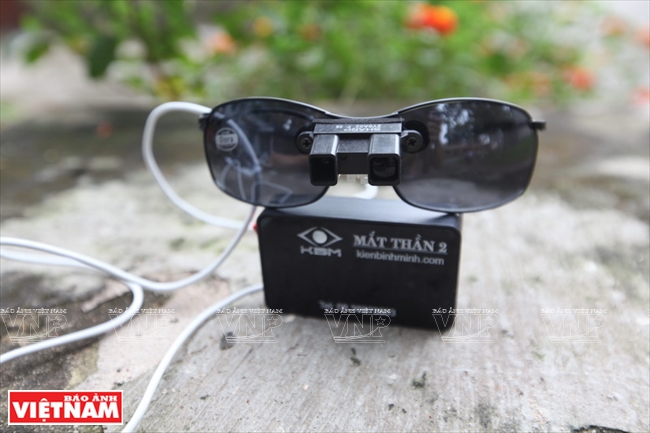học
|
Dr. Nguyen Ba Hai works now as Vice Director of the Centre for High-tech Human Fostering and Training of the Ho Chi Minh City University of Technology and Education. He has had five inventions since the age of 28. He was elected as the typical young citizen of Ho Chi Minh City in 2012 and one of ten exemplary Vietnamese young people in 2014.
|
The scientist and his colleague at the Digital Teaching Centre in the Ho Chi Minh City University of Technology and Education researched and successfully produced thousands of “haptic eyes” to present to the blind in the provinces of Phu Yen, Binh Dinh and Long An.
Nguyen Ba Hai, a native of Thanh Hoa Province, is now working as the head of a group researching bio-robotics at the Ho Chi Minh City University of Technology and Education. He is an ebullient man with a sense of humor and has had a great passion for science since he was a student. Seeing the blind facing many difficulties in their daily life, he promised himself to invent equipment to help the blind. That idea haunted him even during the time he studied in RoK. After successfully defending his doctorial thesis on bio-robotics in RoK, he returned to Vietnam and started his “haptic eyes” project.
A haptic lens, also called a sclera lens or sclera shell, is an artificial eye that works better than a stick for the blind because it can detect obstacles in high positions, whereas sticks are usually useful for touching objects on the ground only. Moreover, “haptic eyes” can also identify if an obstacle stands still or moves. To make “haptic eyes”, Hai spent more than four years doing research on the product that was tested and improved nine times. There were some occasions when his project seemed to come to a dead-end because of the failure in his experiments. Yet, he was never discouraged and was determined to look for reasons for his failures. The first version of a “haptic eye” was a 3kg hat and then an object kept around the head and other versions. Until the 9th version did he get success and his invention won the humanity award at the Robocon Techshow 2012 and the first prize at Vietnam’s Invention Week 2013.
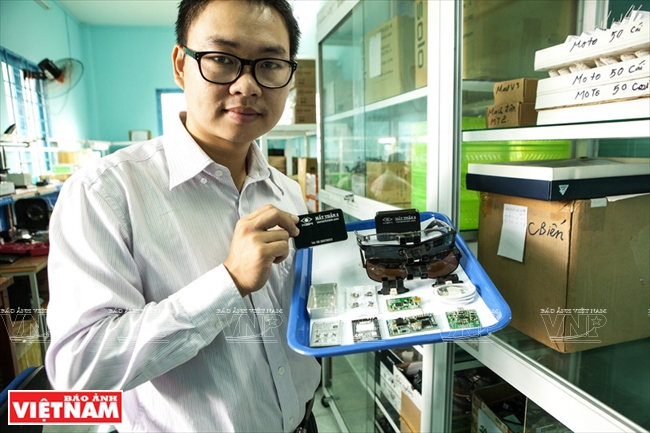 Dr. Nguyen Ba Hai and different versions of “haptic eyes” that he created. Photo: Thong Hai/VNP 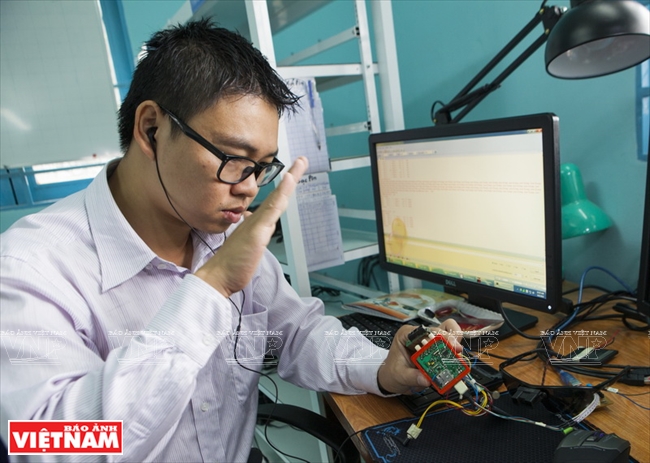 Dr. Nguyen Ba Hai tests the shaking of “haptic eyes”. Photo: Thong Hai/VNP 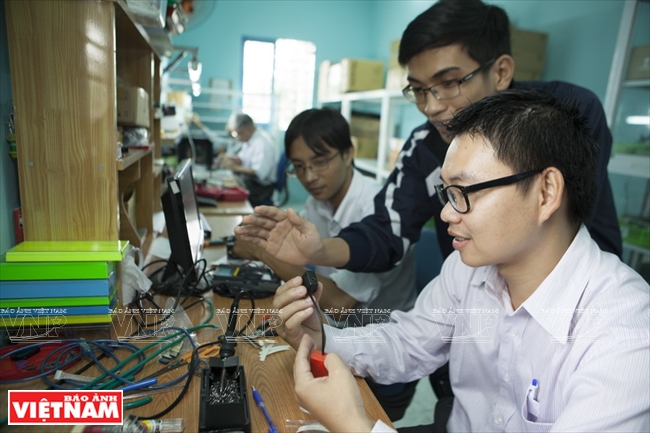 Dr. Nguyen Ba Hai and his partners at the factory of “haptic eyes”. Photo: Thong Hai/VNP |
Hai acknowledged that to test “haptic eyes”, he successfully experimented with two visually-impaired people, including Quang Minh, a sponge cake seller near Nguyen Tri Phuong Bridge, District 10, Ho Chi Minh City who was born blind, and Le Giang, a lottery ticket seller in Cu Chi District. Wearing “haptic eyes” these two men can easily move about and feel very free in their daily life.
His invention was highly valued by many domestic and foreign organisations and many of them wanted to buy it for billions dong, but he refused. He said: “If I sell haptic eyes, companies will earn high profits, whereas, the blind and the poor will have fewer chances to use it, so I can not sell my invention and instead can present it to society and visually-impaired people”. He established Kien Binh Minh Company and called on donors and the company’s help to produce “haptic eyes” to present to the poor blind.
After listening to Hai’s presentation of his invention, Prime Minister Nguyen Tan Dung decided to provide support for Hai and his research team to implement their project, which is meaningful for the entire society. The Prime Minister also requested Hai to expand the scale of production and he asked related ministries to work with Hai to accelerate the implementation of the project.
Vietnam now has about 1.2 million people with visual impairments at different levels and 300,000 completely blind people who need “haptic eyes”. Therefore, it is a good news for the blind community when the project of Hai received support of the state.
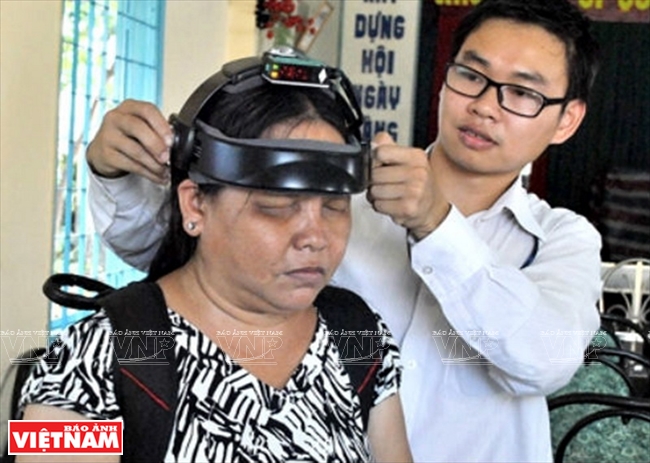 The first version of “haptic eyes”. Photo: File 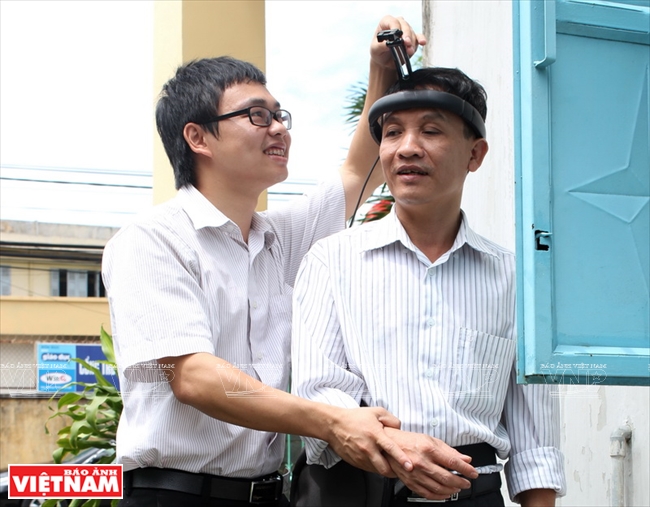 Testing the second version of “haptic eyes”. Photo: File 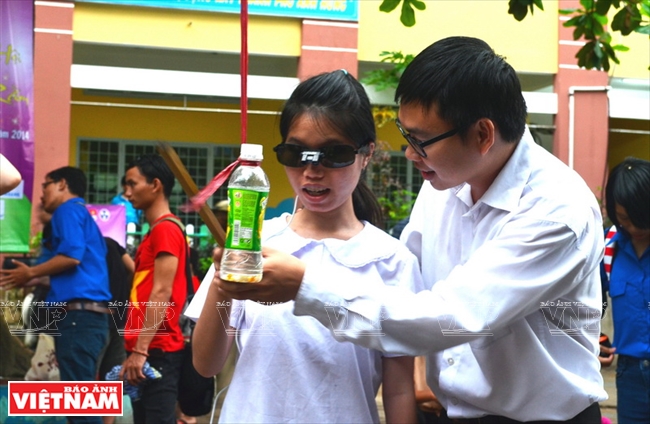 When approaching an obstacle, the control system will shake to inform the blind so they can avoid it or find other routes. Photo: File “Haptic eyes” help blind people travel easier. Photo: File  Old Quang Minh, a blind person who sells sponge cakes near Nguyen Tri Phuong Bridge in District 10, uses “haptic eyes”. Photo: Thong Hai/VNP |

